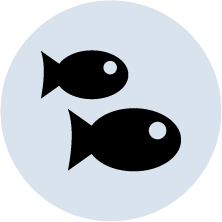What can I do?
Think what you eat

Reduce your meat intake. International assessments state that the current beef production practices have the greatest impact on eutrophication and climate change, e.g. because fertilizers used in the fields cause excess algal blooms in the Baltic Sea.
Treat your wastewater

Wastewater from summer cottages – or any houses – near bodies of water may get washed into the Baltic Sea. This wastewater contains eutrophicating nutrients and various hazardous chemicals, It is important to treat wastewater properly!
Favour local fish

You can help to reduce eutrophication by eating wild fish, such as bream, roach and herring caught in the Baltic Sea.
Also, remember that a lot of unnecessary emissions come from food waste. So, eat what you buy and keep waste to a minimum!
Other resources
- Eutrophication – the greatest threat to the Baltic Sea (Baltic Sea Action Group)
- Possible solutions for eutrophication (a more global viewpoint! Storymap by Ryan Hanna)
- Ten ways to protect the Baltic Sea in everyday life (Baltic Sea Action Group)
What is HELCOM doing about it?
Inputs of nitrogen and phosphorus have been increasing for a long time in the Baltic Sea, mainly between the 1950s and the late 1980s, causing eutrophication symptoms of increasing severity to the ecosystem. As a response to the deteriorating development, actions to reduce nutrient loading were agreed on by the 1988 HELCOM Ministerial Declaration, and reaching a Baltic Sea unaffected by eutrophication is included as one of the main goals of the Baltic Sea Action Plan (BSAP).
Several HELCOM eutrophication assessments have been carried out since the agreement of the Baltic Sea Action Plan, to follow-up on the status of eutrophication of the Baltic Sea. Further, the Nutrient Reduction Scheme has been operational since 2013.
HELCOM also regularly produces a Pollution Load Compilations (PLC) which assesses the data collected by the coastal states on total air and waterborne inputs of nutrients, as well as some hazardous substances, to the Baltic Sea.
Further reading:
Baltic Sea knowledge: Eutrophication
HELCOM Action Areas:
Nutrient Input Reduction Scheme
